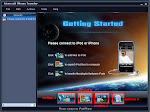Author: Mangal // Category:
 In 2001 125 million personal computers were shipped in comparison to 48 thousand in 1977. More than 500 million personal computers were in use in 2002 and one billion personal computers had been sold worldwide since mid-1970s until this time. Of the latter figure, 75 percent were professional or work related, while the rest sold for personal or home use. About 81.5 percent of personal computers shipped had been desktop computers, 16.4 percent laptops and 2.1 percent servers. United States had received 38.8 percent (394 million) of the computers shipped, Europe 25 percent and 11.7 percent had gone to Asia-Pacific region, the fastest-growing market as of 2002. The second billion was expected to be sold by 2008. Almost half of all the households in Western Europe had a personal computer and a computer could be found in 40 percent of homes in United Kingdom, compared with only 13 percent in 1985.
In 2001 125 million personal computers were shipped in comparison to 48 thousand in 1977. More than 500 million personal computers were in use in 2002 and one billion personal computers had been sold worldwide since mid-1970s until this time. Of the latter figure, 75 percent were professional or work related, while the rest sold for personal or home use. About 81.5 percent of personal computers shipped had been desktop computers, 16.4 percent laptops and 2.1 percent servers. United States had received 38.8 percent (394 million) of the computers shipped, Europe 25 percent and 11.7 percent had gone to Asia-Pacific region, the fastest-growing market as of 2002. The second billion was expected to be sold by 2008. Almost half of all the households in Western Europe had a personal computer and a computer could be found in 40 percent of homes in United Kingdom, compared with only 13 percent in 1985.
The global personal computer shipments were 264 million units in the year 2007, according to iSuppli, up 11.2 percent from 239 million in 2006. In year 2004, the global shipments was 183 million units, 11.6 percent increase over 2003. In 2003, 152.6 million computers were shipped, at an estimated value of $175 billion. In 2002, 136.7 million PCs were shipped, at an estimated value of $175 billion. In 2000, 140.2 million personal computers were shipped, at an estimated value of $226 billion. Worldwide shipments of personal computers surpassed the 100-million mark in 1999, growing to 113.5 million units from 93.3 million units in 1998. In 1999, Asia had 14.1 million units shipped.As of June 2008, the number of personal computers in use worldwide hit one billion, while another billion is expected to be reached by 2014. Mature markets like the United States, Western Europe and Japan accounted for 58 percent of the worldwide installed PCs. The emerging markets were expected to double their installed PCs by 2013 and to take 70 percent of the second billion PCs. About 180 million computers (16 percent of the existing installed base) were expected to be replaced and 35 million to be dumped into landfill in 2008. The whole installed base grew 12 percent annually.
In the developed world, there has been a vendor tradition to keep adding functions to maintain high prices of personal computers. However, since the introduction of One Laptop per Child foundation and its low-cost XO-1 laptop, the computing industry started to pursue the price too. Although introduced only one year earlier, there were 14 million netbooks sold in 2008.Besides the regular computer manufacturers, companies making especially rugged versions of computers have sprung up, offering alternatives for people operating their machines in extreme weather or environments.
The first advertisement for iPhone, titled "Hello," aired during the 79th Academy Awards on February 25, 2007 on ABC. The ad features clips from several notable films and television shows over the last seventy years, showing iconic characters answering telephones and saying "hello" or a similar greeting. The iPhone is shown at the end with the caption "Hello. Coming in June."
The commercial was created by TBWA\Chiat\Day, Apple's ad agency since CEO Steve Jobs' return to the company in 1997. TBWA's Media Arts Lab will continue to handle all upcoming advertising for iPhone, much as it has for iPod.
On June 3, 2007, Apple released four advertisements announcing a June 29, 2007 release date. A fifth ad featuring YouTube was released on June 21, 2007. All five advertisements feature a voice over describing various iPhone features, demonstrated on-screen. The song "Perfect Timing (This Morning)" by Orba Squara plays in the background.[citation needed]
The first publicly released iPhone 3G ad was first shown at WWDC 2008. Since then, iPhone 3G ads have been similar to those of the original iPhone; however, the background is white and the music used is "You, Me, and the Bourgeoisie" by The Submarines and can be viewed on Apple's website.[citation needed]
One iPhone television advertisement was banned in the UK after the Advertising Standards Authority decided that the ad made false claims about the device's ability to access websites, and did not mention limitations in doing so.
 Once upon a time, orchestras required instruments. Then computers reproduced the sounds of symphonies. Now, band geeks are playing iPhones.
Once upon a time, orchestras required instruments. Then computers reproduced the sounds of symphonies. Now, band geeks are playing iPhones.



 Turing machine."
Turing machine."

Counter